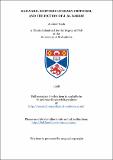Files in this item
Kailyard, Scottish literary criticism, and the fiction of J. M. Barrie
Item metadata
| dc.contributor.advisor | Crawford, Robert | |
| dc.contributor.advisor | Mallett, Phillip | |
| dc.contributor.author | Nash, Andrew | |
| dc.coverage.spatial | vi, 312 p. | en_US |
| dc.date.accessioned | 2018-07-10T14:43:40Z | |
| dc.date.available | 2018-07-10T14:43:40Z | |
| dc.date.issued | 1998-12 | |
| dc.identifier.uri | https://hdl.handle.net/10023/15199 | |
| dc.description.abstract | This thesis argues that the term Kailyard is not a body of literature or cultural discourse, but a critical concept which has helped to construct controlling parameters for the discussion of literature and culture in Scotland. By offering an in-depth reading of the fiction of J.M. Barrie - the writer who is most usually and misleadingly associated with the term - and by tracing the writing career of Ian Maclaren, I argue for the need to reject the term and the critical assumptions it breeds. The introduction maps the various ways Kailyard has been employed in literary and cultural debates and shows how it promotes a critical approach to Scottish culture which focuses on the way individual writers, texts and images represent Scotland. Chapter 1 considers why this critical concern arose by showing how images of national identity and national literary distinctiveness were validated as the meaning of Scotland throughout the nineteenth century. Chapters 2-5 seek to overturn various assumptions bred by the term Kailyard. Chapter 2 discusses the early fiction of J.M. Barrie in the context of late nineteenth-century regionalism, showing how his work does not aim to depict social reality but is deliberately artificial in design. Chapter 3 discusses late Victorian debates over realism in fiction and shows how Barrie and Maclaren appealed to the reading public because of their treatment of established Victorian ideas of sympathy and the sentimental. Chapter 4 discusses Barrie's four longer novels - the works most constrained by the Kailyard term - and chapter 5 reconsiders the relationship between Maclaren's work and debates over popular culture. Chapter 6 analyses the use of the term Kailyard in twentieth-century Scottish cultural criticism. Discussing the criticism of Hugh MacDiarmid, the writing of literary histories and studies of Scottish film, history and politics, I argue for the need to reject the Kailyard term as a critical concept in the discussion of Scottish culture. | en_US |
| dc.language.iso | en | en_US |
| dc.publisher | University of St Andrews | |
| dc.subject.lcc | PR8623.K2N2 | |
| dc.subject.lcsh | Barrie, J. M. (James Matthew), 1860-1937--Criticism and interpretation | en |
| dc.subject.lcsh | English literature--Scottish authors--History and criticism | en |
| dc.subject.lcsh | Maclaren, Ian, 1850-1907--Criticism and interpretation | en |
| dc.subject.lcsh | Popular culture--Scotland | en |
| dc.subject.lcsh | English literature--19th century--History and criticism | en |
| dc.title | Kailyard, Scottish literary criticism, and the fiction of J. M. Barrie | en_US |
| dc.type | Thesis | en_US |
| dc.contributor.sponsor | British Academy. Humanities Research Board | en_US |
| dc.type.qualificationlevel | Doctoral | en_US |
| dc.type.qualificationname | PhD Doctor of Philosophy | en_US |
| dc.publisher.institution | The University of St Andrews | en_US |
This item appears in the following Collection(s)
Items in the St Andrews Research Repository are protected by copyright, with all rights reserved, unless otherwise indicated.

